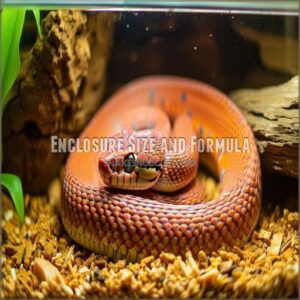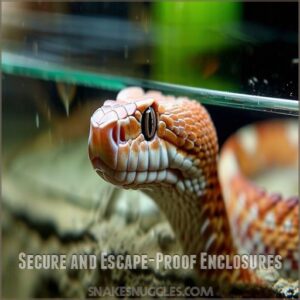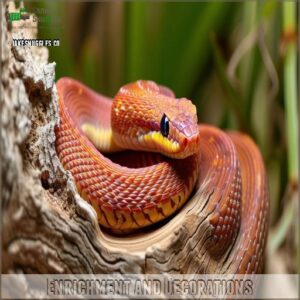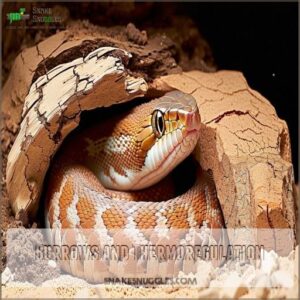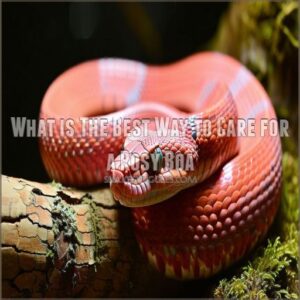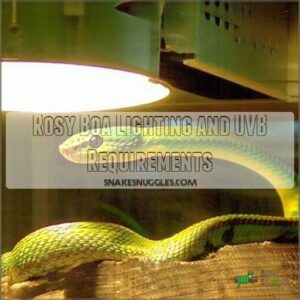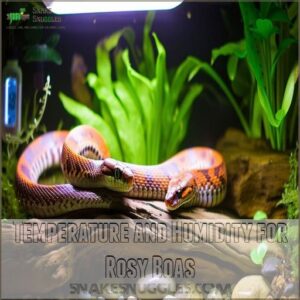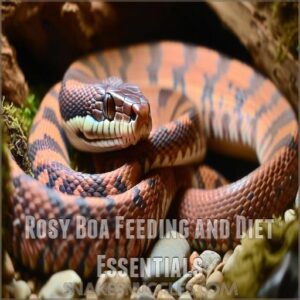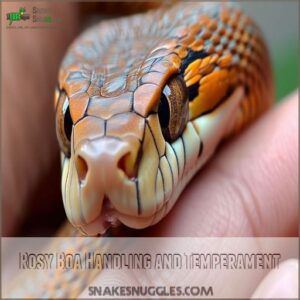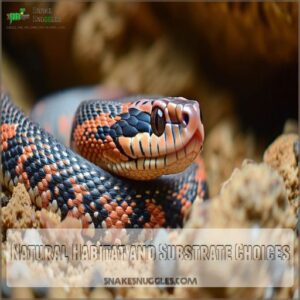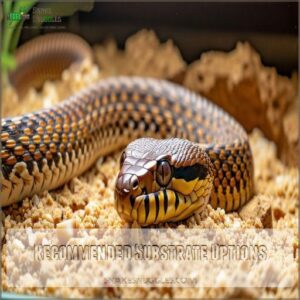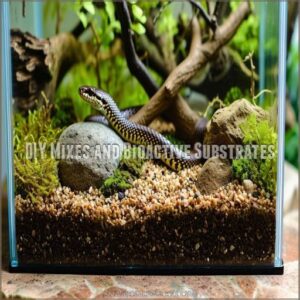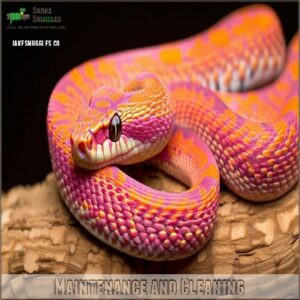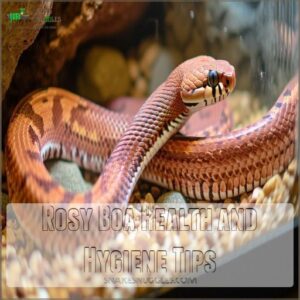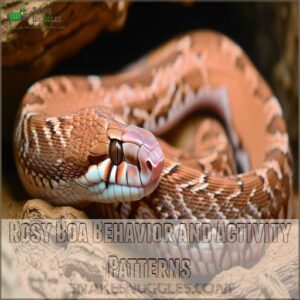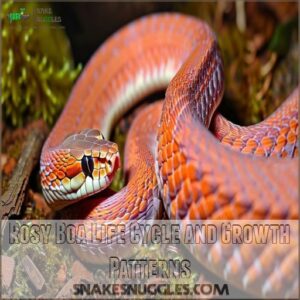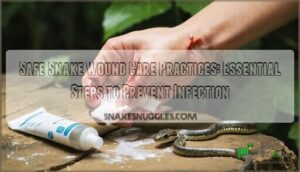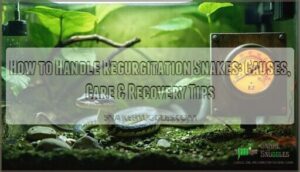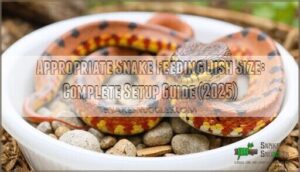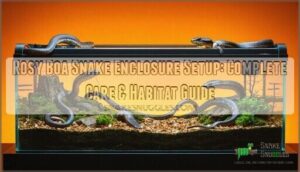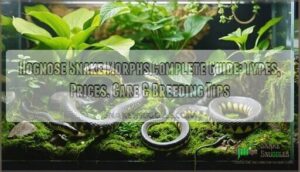This site is supported by our readers. We may earn a commission, at no cost to you, if you purchase through links.
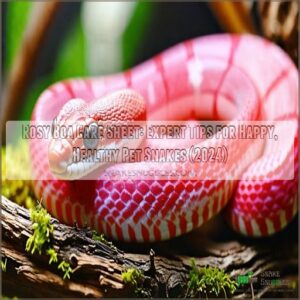 Caring for a rosy boa isn’t rocket science, but it does require attention to detail.
Caring for a rosy boa isn’t rocket science, but it does require attention to detail.
Start with a secure, escape-proof enclosure—think of it as their cozy fortress.
Make sure temperatures range from 75°F to 85°F, with a basking area bumping up to 90°F.
Lighting isn’t essential since they’re mostly nocturnal, but providing UVB can’t hurt.
Feeding them thawed mice every 7-10 days keeps them satisfied.
Remember, handling should be gentle; they’re snakes, not stress balls!
For substrate, use aspen bedding to mimic their natural habitat.
Now, are you curious about the playful antics this snake might display? Stay tuned!
Table Of Contents
- Key Takeaways
- Rosy Boa Habitat Setup
- What is The Best Way to Care for a Rosy Boa
- Rosy Boa Lighting and UVB Requirements
- Temperature and Humidity for Rosy Boas
- Rosy Boa Feeding and Diet Essentials
- Rosy Boa Handling and Temperament
- Rosy Boa Substrate and Bioactive Options
- Rosy Boa Health and Hygiene Tips
- Rosy Boa Behavior and Activity Patterns
- Rosy Boa Life Cycle and Growth Patterns
- Frequently Asked Questions (FAQs)
- Conclusion
Key Takeaways
- Ensure your rosy boa’s enclosure is secure and at least three times their length, featuring multiple hiding spots and a temperature gradient from 75-90°F. A good starting point is a 40-50 gallon enclosure for adults, as recommended in rosy boa enclosure guidelines.
- Feed your snake frozen-thawed mice every 10-14 days for adults, making sure prey isn’t wider than 1.5 times their thickest body part, and maintain a clean feeding routine.
- Handle your rosy boa gently for 10-15 minutes daily, watching for signs of stress like tight coiling or rapid breathing; this builds trust and keeps them comfortable.
- Use a well-chosen substrate like aspen bedding to encourage natural burrowing, and keep humidity below 60% to create a healthy desert-like environment.
Rosy Boa Habitat Setup
You’ll need a secure enclosure at least three times your rosy boa‘s length to create a cozy home that prevents escape attempts.
Your snake‘s habitat should include essential features like proper ball python substrate options that control humidity and allow for natural burrowing, multiple hideouts, and temperature zones ranging from 75-90°F to keep your scaly friend comfortable and thriving.
Enclosure Size and Formula
Space matters when it comes to your rosy boa’s happiness.
Your enclosure should be at least 3 times your snake’s length to make sure it can move around properly and regulate its body temperature.
Here’s what to think about when sizing your boa’s home:
- A 20-gallon tank works well for most adult rosy boas
- Calculate minimum width as 1/3 of the enclosure length
- Height should be at least 1/2 the enclosure width
- Think about future growth when choosing size
- Add extra space for enrichment items and temperature zones
Secure and Escape-Proof Enclosures
You’ve got the size figured out – now let’s make sure your rosy boa stays put!
These sneaky serpents are master escape artists, so you’ll need an enclosure with a secure, locking lid.
Front-opening terrariums with sturdy latches work best, while screen tops should have clips or locks.
Remember to check the ventilation gaps – if your snake’s head can fit through, their whole body can follow!
Enrichment and Decorations
To create an ideal environment for your rosy boa, consider a habitat size that’s at least 24 x 18 x 18 inches, offering ample space for climbing and exploration, as recommended for proper rosy boa habitat. Transform your rosy boa’s habitat into a miniature natural playground with live plants, cork logs, and hideouts.
Add climbing structures at various heights to encourage natural behaviors, and make sure substrate depth allows for gentle burrowing.
Think of it as creating a five-star snake resort – mix in cholla wood, sturdy branches, and drought-resistant plants.
Your snake will thank you with increased activity and exploration.
Burrows and Thermoregulation
Many rosy boas spend hours perfecting their burrows in the wild, similar to their wild relatives that are fascinating underground ecosystem engineers, and your pet needs the same opportunity.
Create multiple hideouts at different heights and temperatures using cork bark, PVC pipes, or commercial hides.
Position them across the temperature gradient so your snake can thermoregulate effectively.
Line the burrows with substrate that holds shape, like a mix of topsoil and sand, to satisfy their natural digging instincts.
What is The Best Way to Care for a Rosy Boa
With proper care, a rosy boa can thrive in captivity for over 20 years.
These gentle serpents need a consistent routine to maintain their health and happiness.
Let’s break down the essential care requirements:
- Set up a secure enclosure that’s at least 3 times your snake’s length, equipped with multiple hiding spots and climbing opportunities using cork bark, branches, and artificial plants.
- Maintain proper temperature gradients between 75-90°F using high-quality heating equipment, and keep humidity below 60% while providing a humid hide.
- Feed appropriately sized frozen-thawed prey every 5-7 days for juveniles or 10-14 days for adults, always washing hands before and after handling.
- Monitor your snake’s health daily, watching for signs of illness like respiratory issues, unusual behavior, or changes in eating habits, and schedule regular vet check-ups.
Rosy Boa Lighting and UVB Requirements
You’ll need to provide your rosy boa with low-intensity UVB lighting to maintain their natural day-night cycle and support vitamin D3 synthesis, even though they’re primarily nocturnal.
For good results, you’ll want to position your UVB bulb on the warm side of the enclosure, ensuring it covers about one-third to one-half of the total space.
Nocturnal Nature and UVB Needs
Your Rosy Boa’s nocturnal nature doesn’t mean they don’t need UVB lighting.
These secretive serpents still benefit from low-intensity UVB exposure to regulate their day/night cycles and support vitamin D3 synthesis.
While they’re most active at night, providing proper UVB during the day helps mimic their natural habitat where they’d receive filtered sunlight through rock crevices and desert brush.
Choosing The Right UVB Bulb
Two essential UVB bulbs stand out for rosy boas: the Arcadia ShadeDweller and Zoo Med T5 HO Reptisun 5.0.
These specialized bulbs deliver the perfect UVB intensity without overwhelming your nocturnal friend.
Remember to check your bulb’s output with a Solarmeter 6.5 for best care.
- Replace UVB bulbs every 12 months, even if they’re still glowing
- Choose T5 HO bulbs over T8s for better UVB penetration
- Look for bulbs rated between 5-7% UVB output
Placement and Mesh Obstruction
Proper UVB bulb placement makes all the difference in your rosy boa’s health.
Position the basking platform 7-9 inches from mesh-covered UVB bulbs, or 10-12 inches without mesh interference.
Remember, screen tops can block up to 40% of UVB rays, so you’ll need to adjust distances accordingly.
A Solarmeter 6.5 helps pinpoint the perfect spot for achieving that sweet 2.0-3.0 UVI range.
While also considering best overhead heating sources.
Recommended UVB Bulbs and Lighting
Three top-rated UVB options stand out for rosy boas: the Arcadia ShadeDweller, Arcadia T5 HO 6%, and Zoo Med T5 HO Reptisun 5.0.
Each provides essential UVB radiation while mimicking natural sunlight patterns.
For best results, pair these with a timer set to 12-14 hours daily.
Remember to replace UVB bulbs every 6-12 months, as their effectiveness diminishes even when they still emit visible light.
Temperature and Humidity for Rosy Boas
You’ll need to create distinct temperature zones in your rosy boa’s enclosure, with a basking area of 85-90°F and a cool side of 75-80°F.
While these snakes don’t need high humidity, you’ll want to maintain levels below 60% and provide a humid hide on the cool side for proper shedding.
Cold-Blooded Nature and Temperature Needs
Unlike mammals that generate their own heat, your rosy boa relies entirely on external temperatures to regulate its body functions.
You’ll need to maintain specific temperature zones in their enclosure to support digestion, immunity, and overall health.
A cold-blooded snake can’t simply warm up by moving around – they depend on you to create the perfect temperature environment for their survival and well-being.
Heat Sources and Basking Areas
A well-designed basking area is very important for your rosy boa’s health.
Mount halogen flood bulbs above a spacious platform that’s large enough for your snake to fully coil under.
You’ll want multiple heat bulbs to create an evenly heated zone, positioned at the right height to achieve 85-90°F on the surface.
Ceramic heat emitters can supplement warmth, but they don’t provide the same quality of heat as halogens.
Temperature Gradients and Nighttime Cooling
Creating a temperature gradient lets your rosy boa choose its perfect spot throughout the day.
Set up your heat source to maintain 85-90°F in the basking area, with a gradual drop to 75-80°F in the cool zone.
When night falls, let temperatures naturally decrease to 60°F – it mimics their desert habitat and supports healthy digestion.
During winter months, this cooling cycle becomes even more important.
Thermometers and Temperature Measurement
Getting accurate temperature readings means investing in reliable tools.
You’ll need both an infrared thermometer for spot-checking basking surfaces and a digital probe thermometer to monitor ambient temperatures in different areas.
Place probes in the warm and cool sides of your enclosure, and check them daily.
Remember to calibrate your thermometers every few months to maintain accuracy – your rosy boa’s health depends on precise readings.
Rosy Boa Feeding and Diet Essentials
You’ll need to master your rosy boa’s feeding schedule and prey selection, considering their solitary nature and potential for stress in cohabitation setups like a spacious enclosure with multiple hides.
Adults can happily feast on appropriately-sized frozen mice every 10-14 days.
Juveniles will need to be fed more frequently, offering meals every 5-7 days to support their growth.
Frozen Thawed Mice and Feeding Frequency
For a rosy boa’s optimal health, selecting prey items no wider than the snake’s body at its largest girth is crucial, as part of a well-planned rosy boa feeding schedule. For feeding your rosy boa, frozen-thawed mice are the safest and most practical choice.
You’ll want to thaw prey items in the refrigerator overnight, then warm them to room temperature in a plastic bag placed in warm water.
For most adult rosy boas, establish a feeding schedule of every 10-14 days.
Remember never to microwave prey items, as this can cause dangerous hot spots.
Prey Size and Type
The size and type of prey you offer your rosy boa matters as much as the feeding schedule.
Choose prey items that measure no wider than 1.5 times your snake’s body width at its thickest point.
Your rosy boa will thrive on a varied diet, similar to their wild hunting habits.
- Mice remain the go-to staple for most rosy boa keepers
- Small rats offer extra nutrition for larger specimens
- Consider adding quail eggs or chicks for dietary enrichment
Juvenile and Adult Diets
You’ll notice different feeding patterns between juvenile and adult rosy boas.
Feed your young snake every 5-7 days with appropriately sized prey, while adults can go 10-14 days between meals.
Your juvenile needs steady nutrition for healthy growth, so maintain a consistent schedule.
Once they reach adulthood, they’ll naturally eat less frequently but might take slightly larger prey items.
Wild Prey and Dietary Variety
Hungry rosy boas in their natural habitat feast on a diverse menu of small mammals, lizards, and even other snakes.
While it’s best to stick with frozen-thawed prey in captivity, understanding their wild diet helps replicate their nutritional needs.
Here’s what wild rosy boas typically hunt:
- Deer mice and kangaroo rats
- Desert lizards and small skinks
- Juvenile snakes and occasional amphibians
Consider offering varied prey sizes to mimic natural hunting patterns.
Rosy Boa Handling and Temperament
You’ll find that rosy boas have a calm, friendly demeanor and are rarely aggressive, making them suitable for households with other pets and allowing for relatively easy snake handling. They are among the most gentle and easygoing pet snakes you can own, making them perfect for both beginners and experienced keepers.
With proper socialization and consistent handling sessions of 10-15 minutes each day, you’ll quickly develop a comfortable relationship with your docile companion.
Docile Nature and Handling Tips
Most Rosy Boas prove themselves to be remarkably gentle pets, rarely showing aggression during handling.
To build trust and confidence, you should establish a routine with gentle boa handling sessions.
When picking up your snake, support its entire body and avoid quick movements that might startle it.
Keep sessions brief, especially after meals, and watch for stress signs like tight coiling or head hiding.
Always wash your hands before and after handling to prevent the spread of bacteria.
Socialization and Taming
Socializing your Rosy Boa starts with patience and consistency.
Gentle daily interactions help build trust and create a lasting bond.
Here’s what a successful socialization routine looks like:
- Start with short 5-minute sessions, letting your snake get used to your scent
- Place your hand in the enclosure without grabbing, allowing curious exploration
- Gradually increase handling time to 10-15 minutes
- Keep sessions calm and predictable, avoiding sudden movements
Common Handling Mistakes
Rosy boas are known for their docile temperament and small size, making them a popular choice for beginner snake owners who can learn from the smallest cutest snake breeds. While pet rosy boas are gentle creatures, there’s an art to handling them properly.
Let’s look at common mistakes to avoid:
| Mistake | What to Do Instead |
|---|---|
| Grabbing from above | Approach from the side |
| Handling without washing hands | Clean hands thoroughly |
| Moving too quickly | Use slow, deliberate movements |
| Squeezing too tight | Support loosely but securely |
| Handling right after meals | Wait 48 hours post-feeding |
Wearing rosy boa gloves can also add an extra layer of protection and comfort for both you and your snake during handling.
Remember, gentle support beats a firm grip every time.
Signs of Stress and Fear
Your rosy boa’s body language speaks volumes about their stress levels.
Just like humans, these snakes display clear signs when they’re feeling uncomfortable or afraid.
Here’s what to watch for:
- Quick breathing or hissing sounds indicate immediate stress
- Tight coiling with the head tucked away suggests fear
- Defensive striking or unusual hiding behavior signals distress
Keep an eye on these signals to build trust with your snake.
Rosy Boa Substrate and Bioactive Options
You’ll need to choose the right substrate to keep your rosy boa healthy and comfortable, as these desert-dwelling snakes love to burrow and explore their environment.
Whether you opt for a traditional setup with reptile sand or create a bioactive habitat with living plants and cleanup crews, your substrate choice will directly impact your snake’s well-being and natural behaviors.
Natural Habitat and Substrate Choices
Rosy boas naturally thrive in diverse habitats across southwestern North America, from rocky deserts to coastal chaparral.
Understanding their native environment helps create an ideal substrate setup that mimics these conditions.
| Natural Habitat | Substrate Needs |
|---|---|
| Desert | Well-draining, sandy |
| Rocky Areas | Firm, compact base |
| Scrubland | Mixed textures |
| Mountains | Temperature stable |
| Coastal | Moisture retaining |
Their burrowing behavior in the wild influences how we should approach substrate selection for captive environments.
Recommended Substrate Options
The best substrate choices for your snake combine practicality with naturalistic appeal.
Zoo Med ReptiSand and Exo Terra Desert Sand lead the pack, offering excellent burrowing opportunities while maintaining proper humidity levels.
For a more sophisticated setup, consider mixing Zoo Med’s Excavator Clay with ReptiSand.
Keep substrate depth at 2-3 inches to support natural behaviors and maintain proper moisture levels.
DIY Mixes and Bioactive Substrates
Creating a DIY substrate mix gives you complete control over your rosy boa’s environment while saving money.
Mix these ingredients for a great bioactive setup:
- 40% organic topsoil (pesticide-free)
- 30% play sand or reptile sand
- 20% coconut fiber
- 10% sphagnum moss
Add springtails and isopods to create a mini-ecosystem that breaks down waste and maintains healthy humidity levels naturally.
Maintenance and Cleaning
Maintaining your bioactive setup demands regular spot-cleaning and occasional deep cleans.
You’ll want to remove waste daily, replace water every 48 hours, and monitor substrate moisture levels weekly.
For traditional setups, plan on replacing one-third of the substrate monthly.
Keep things fresh by disinfecting decor items quarterly with a reptile-safe solution, and always wash your hands before and after maintenance tasks.
Rosy Boa Health and Hygiene Tips
You’ll need to keep your rosy boa’s enclosure clean and monitor their health regularly to prevent common issues like respiratory infections and mites.
Regular vet check-ups and proper quarantine procedures for new snakes will help guarantee your scaly friend stays healthy and thrives in their home.
Common Health Issues and Prevention
Despite their hardy nature, rosy boas can face several health challenges.
Respiratory infections like wheezing or bubbling around the nose can occur.
Regular health checks help spot mite infestations early – look for tiny black dots moving on your snake’s scales.
Keep an eye out for signs of dehydration, including wrinkled skin or retained shed.
A proper temperature gradient and humidity balance prevents most common ailments.
Cleaning and Disinfecting The Enclosure
Through weekly spot-cleaning and monthly deep-cleaning sessions, you’ll keep your rosy boa’s home fresh and hygienic. Mix a reptile-safe disinfectant according to package directions and target waste removal, substrate changes, and décor sanitization.
- Remove waste and soiled substrate daily
- Clean water dishes with hot, soapy water every 3 days
- Disinfect hides and décor monthly
- Replace substrate completely every 2-3 months
- Sanitize glass walls with reptile-safe cleaner bi-weekly
Veterinary Care and Consultation
Regular visits to a reptile-savvy vet help spot health issues before they become serious.
Schedule annual checkups and keep detailed records of your rosy boa’s weight, feeding, and shedding patterns.
When searching for a vet, look for someone experienced with snakes specifically – not all exotic vets work with reptiles.
Always have an emergency vet’s number handy for after-hours concerns.
Quarantine and Isolation Procedures
When bringing home a new snake, quarantine procedures are your first line of defense against potential health issues.
Set up a separate enclosure away from other reptiles for at least 30 days, monitoring for signs of illness or parasites.
- Keep quarantine supplies separate from your main collection
- Monitor eating, drinking, and bathroom habits daily
- Check for respiratory issues, mites, or unusual behavior
- Document any health concerns for vet consultations
Rosy Boa Behavior and Activity Patterns
You’ll find that rosy boas spend most of their time hidden during daylight hours, as they’re naturally active at dawn, dusk, and throughout the night.
While these secretive snakes might seem lazy during the day, they’re actually conserving energy and regulating their body temperature, preparing for their nocturnal hunting adventures.
Nocturnal and Crepuscular Nature
Rosy boas follow nature’s night shift schedule, becoming most active during dusk and dawn.
You’ll notice your snake perking up as the sun sets, ready to explore and hunt.
Like many nocturnal snakes, they utilize specialized adaptations for hunting in darkness, such as infrared heat detection.
Like tiny vampires of the reptile world, they’ve evolved to thrive in darkness, using their excellent low-light vision and heat-sensing abilities to navigate.
This nocturnal lifestyle helps them avoid predators and stay cool in their desert habitat.
Hiding and Burrowing Behavior
Every successful rosy boa enclosure needs multiple hiding spots to mimic their natural burrowing behavior.
Providing a variety of hides such as a boa hide can help recreate this environment.
You’ll notice your snake spending most daylight hours tucked away, occasionally shifting between hides to regulate temperature.
Make sure you provide at least three secure hiding spots across the temperature gradient, and make sure your substrate is deep enough (4-6 inches) to allow natural burrowing.
Watch how they’ll create their own underground highway system!
Feeding and Hunting Behavior
During nighttime hunts, your rosy boa relies on heat-sensing abilities to track prey movements.
You’ll notice they’re ambush predators, patiently waiting before striking with impressive accuracy.
After catching prey, they’ll constrict it before swallowing whole – head first.
In captivity, they maintain these natural instincts, though you’ll feed pre-killed prey for safety.
Their digestive process typically takes 4-5 days.
Mating and Breeding Behavior
Understanding their mating season helps with breeding success.
Male rosy boas seek out females during spring, using scent trails.
Clutch size varies, usually three to five.
Incubation time lasts 120 to 150 days, depending on temperature.
Make sure proper hatchling care post-birth, like maintaining humidity and safe enclosures.
Fostering these conditions promotes healthy development and thriving young snakes.
Rosy Boa Life Cycle and Growth Patterns
Understanding your rosy boa’s life cycle and growth patterns helps you provide the best care at each stage.
From hatchlings to adults, these docile snakes require adjustments in their environment and diet to support healthy development and longevity.
Hatchling Care and Development
As rosy boa hatchlings emerge, the right care sets the stage for their growth journey.
You’ll need an enclosure snug but with room to explore. Start small, then expand as they grow.
Hatchling feeding involves offering pinky mice weekly.
These tiny boas are delicate, so gentle handling techniques help them trust you.
Watch for health concerns like respiratory issues.
Juvenile Growth and Development
Once your little one sheds that first baby skin, it’s time to focus on their juvenile growth.
Their feeding schedule will change, so keep an eye on their growth rate and consider supplementing their diet with nutrient-rich Rosy Boa Juvenile Food.
Remember, gentle handling tips are key during this phase.
Here’s what to expect:
- Increased appetite
- Faster shedding process
- More active exploration
- Gradual enclosure size increase
Adult Size and Weight
Rosy boas, as adults, mightn’t shock you with their size—typically reaching an average length of about three feet and weighing up to a pound.
Males are usually shorter, often just around 1.5 feet.
Check out this quick reference for size details:
| Aspect | Length | Weight |
|---|---|---|
| Average Size | 2-3 feet | 1 pound |
| Male Size | 1.5-2 feet | 0.8 pounds |
| Female Size | 3 feet | 1 pound |
Lifespan and Longevity
Think of a rosy boa as your buddy for life—potentially up to 20 years!
With good care, including a solid diet and regular checkups, they thrive. Learn more about rosy boa lifespan and care
Key factors affecting lifespan include:
- Average Lifespan: 15-20 years
- Good Care: Regular feeding and clean habitat
- Health Issues: Monitoring for parasites
- Breeding and Longevity: Non-breeders may live longer.
- Handling: Reduces stress, improving longevity.
Frequently Asked Questions (FAQs)
How often should I mist the enclosure?
Mist your rosy boa’s enclosure occasionally to encourage drinking, but make sure it dries out afterward.
Over-misting can lead to too much humidity, so aim for balance—sprinkle lightly and let it dry before misting again.
What size prey is safe to feed?
Feed your boa prey about 10% of its weight, or no bigger than 5 times its body width. Think of it like a healthy, boa-sized portion! Frozen-thawed is safest.
Can rosy boas live together in one enclosure?
When you put two rosy boas in one enclosure, you’ll have a recipe for stress and competition.
Rosy boas thrive best alone due to territorial instincts and differing care needs.
Avoid cohabitation to promote their well-being.
How to identify the gender of a rosy boa?
To identify a rosy boa’s gender, look for subtle differences: males have longer, more pronounced spurs near their vent, while females are generally larger and bulkier.
Consulting a reptile vet can provide accurate determination.
What signs indicate stress in rosy boas?
If your rosy boa seems restless, hides excessively, refuses food, or exhibits rapid breathing, it might be stressed.
A stable environment with proper humidity and temperature, plus gentle handling, helps keep your snake relaxed.
Conclusion
Think of rosy boa care like tending a magical garden—the right habitat nurtures thriving life.
Following this rosy boa care sheet, you’ve equipped yourself to create a cozy, secure home for your snake, balancing temperatures and providing a satisfying diet.
With proper lighting and substrate, your rosy boa will flourish.
Handle them with care, and they’ll reward you with docile temperament.
As you nurture this bond, both snake and owner will experience a journey of companionship.

